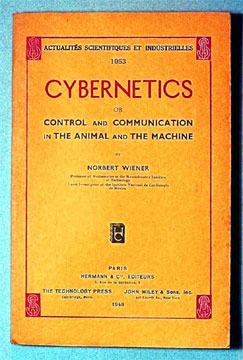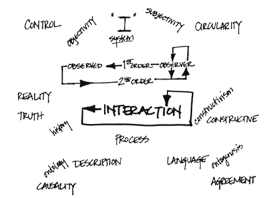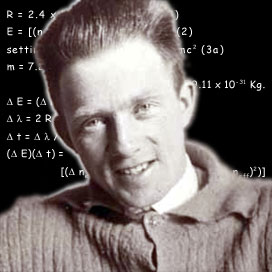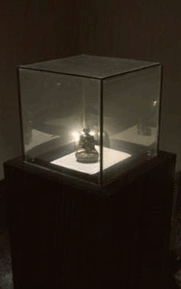Jim Campbell and Interactivity
25 Oct 2005
I have tried to create installations that are less about a viewer dominating a work, and more about viewers participating in the developing personality of a work.
—Jim Campbell
The viewer is an intrinsic component to all of Jim Campbell’s work. Without the participant his installations would be incomplete. The viewer, as in most interactive art, becomes the performer. Because Campbell engineers interfaces into his work, he is creating a relationship between human and machine.
 Norbert Wiener developed a theory about this relationship in his essay “Cybernetics in History” The Human Use of Human Beings. Wiener defines cybernetics as a system of communication between human and machine or machine and machine. Cybernetics is an essential theory for interactive artwork because it is based on the idea that a human action is followed by a mechanical reaction. It can be seen as a communicative relationship between the two entities. Wiener believes that a machine is capable of interpreting information and creating a response. He likens a command to a computer to perform an action to ordering another person to perform a task. If both the person and the machine carry out the order then their response can be considered equivalent. This to Wiener is a form of two-way communication.
Norbert Wiener developed a theory about this relationship in his essay “Cybernetics in History” The Human Use of Human Beings. Wiener defines cybernetics as a system of communication between human and machine or machine and machine. Cybernetics is an essential theory for interactive artwork because it is based on the idea that a human action is followed by a mechanical reaction. It can be seen as a communicative relationship between the two entities. Wiener believes that a machine is capable of interpreting information and creating a response. He likens a command to a computer to perform an action to ordering another person to perform a task. If both the person and the machine carry out the order then their response can be considered equivalent. This to Wiener is a form of two-way communication.
If interactivity can be loosely defined as a reciprocal relationship between two things such as a man and a machine, then Campbell’s work, because of its use of interface, easily fits into Wiener’s cybernetics theory. However, Campbell believes that the term interactivity should not be used in relationship to computers. He feels that people have ultimate control over a computer; therefore a reciprocal relationship is impossible. He believes that since humans give computers commands then there can be no sense of communication between the two, as he states in an interview with Richard Whittaker.
 Campbell does not want Wiener’s idea of interactivity to be the driving force of his work. He designs the interactive interface in such a way that it never distracts the viewer. He wants the interactivity to occur within the viewer alone, not between his piece and the viewer. The interaction happens in the viewer’s head as the experience of his work is pondered.
Campbell does not want Wiener’s idea of interactivity to be the driving force of his work. He designs the interactive interface in such a way that it never distracts the viewer. He wants the interactivity to occur within the viewer alone, not between his piece and the viewer. The interaction happens in the viewer’s head as the experience of his work is pondered.
Campbell’s work is inherently based in technology, due to his background in electrical engineering and mathematics. Unlike most artists using technology, Campbell has the ability to think through an idea and develop the apparatus to make it happen. The pitfall for many artists working with technology is that the technology clouds their vision. For many artists technology is a contrivance, overpowering the expression of ideas. For instance Jeffery Shaw’s piece, Place : a User’s Manual, is a computer-generated, panoramic scene, with which the viewer can interact by means of a modified video camera as a controlling device, and the image itself cannot escape the technology used to create it. How can the viewer experience this alternate reality if they are mired in the technology used to make the work? This type of work is solely about technology. The interface, often game-like, never allows the viewer to transcend the technology. For Campbell, the technology never overshadows the work; it is simply incorporated.
 His two works Untitled (for Heisenberg) and Shadow (for Heisenberg) are excellent examples of how he uses technology to convey a message, but at the same time completely conceals the interface. These two pieces are based on the “Uncertainty Principle,” a theory developed by the physicist Werner Heisenberg. In quantum theory, this principle states that the as one tries to observe or measure something more and more precisely, it becomes more and more obscure. The activity of observation has a direct impact on the object. “The more precisely the position is determined, the less precisely the momentum is known.” Campbell translates this theory into an artistic idea. With these pieces he asks how does one then gain true knowledge of a piece of art if one can never truly observe anything without changing it?
His two works Untitled (for Heisenberg) and Shadow (for Heisenberg) are excellent examples of how he uses technology to convey a message, but at the same time completely conceals the interface. These two pieces are based on the “Uncertainty Principle,” a theory developed by the physicist Werner Heisenberg. In quantum theory, this principle states that the as one tries to observe or measure something more and more precisely, it becomes more and more obscure. The activity of observation has a direct impact on the object. “The more precisely the position is determined, the less precisely the momentum is known.” Campbell translates this theory into an artistic idea. With these pieces he asks how does one then gain true knowledge of a piece of art if one can never truly observe anything without changing it?
Campbell illustrates this idea in Untitled (for Heisenberg) by projecting an image of a couple lying on a platform covered with salt. The platform looks like a bed and the salt alludes to crumpled sheets. From a distance, the couple appears to be in an intimate embrace (this is not clear from the initial view of the piece). As the viewer walks down the dark hallway to get a better look, sensors in the hallway make the image in the projection move according to the viewer’s movements. The image of the couple gets larger depending on how close the viewer gets to the platform. The projection zooms in so close that the bodies become unrecognizable. This is a direct translation of Heisenberg’s theory: the closer one examines something, the more obscure it becomes. The piece makes it impossible to view anything tangible. The viewer is left interacting in his or her own mind, as Campbell intends. Untitled (for Heisenberg) engages the voyeuristic aspect of the viewer’s psyche. A viewer’s instinct in a gallery is to move closer to an artwork in order to understand it. Because of the intimacy of a couple in bed, the viewer inevitably feels voyeuristic. The technological interface is necessary to express the complicated ideas this piece brings to mind, but it does not infringe on the integrity of the piece.
 Shadow (for Heisenberg) uses the same concept of obscuring an object that the viewer wants to see. In this work, a statue of Buddha sits on a page of text, enclosed in a glass case. When the viewer approaches the piece, the statue fades from view and it is replaced with a shadow of the sculpture. This is achieved through technology that Campbell developed that allows that glass to turn from transparent to translucent. This work challenges our need to examine the material world and our role as an observer. The basic urge of viewing has been disrupted: we seek to examine and gain knowledge of the Buddha but instead of reaching enlightenment we are left with uncertainty. Again directly referencing Heisenberg’s principle that everything is uncertain because nothing can ever be definitively observed.
Shadow (for Heisenberg) uses the same concept of obscuring an object that the viewer wants to see. In this work, a statue of Buddha sits on a page of text, enclosed in a glass case. When the viewer approaches the piece, the statue fades from view and it is replaced with a shadow of the sculpture. This is achieved through technology that Campbell developed that allows that glass to turn from transparent to translucent. This work challenges our need to examine the material world and our role as an observer. The basic urge of viewing has been disrupted: we seek to examine and gain knowledge of the Buddha but instead of reaching enlightenment we are left with uncertainty. Again directly referencing Heisenberg’s principle that everything is uncertain because nothing can ever be definitively observed.
Campbell uses technology to enhance the viewer’s experience of his work. He does not use the interface as a type of game to play with the viewer or to set up a two-way conversation between man and machine. What is important to Campbell is to create an interesting environment that allows the viewer to understand a thought. The viewer takes a role in shaping the piece. It is through the participation of the observer that Campbell’s work becomes fully realized.
Megan Walbornmeganwalborn@yahoo.com
◊
References:
Whittaker, Richard. “Interview with Jim Campbell.” Works + Conversations, May 1999. www.conversations.org/jim_campbell.htm
Randall Packer and Ken Jordan, ed. Multimedia From Wagner to Virtual Reality.